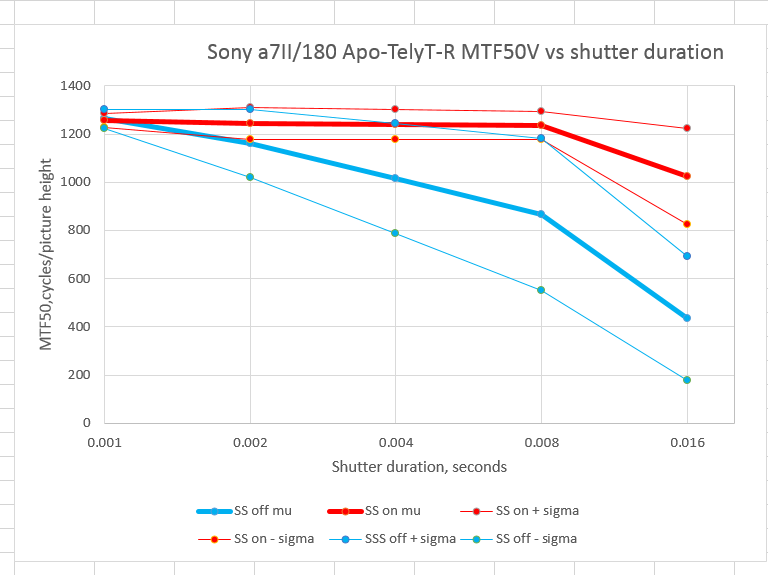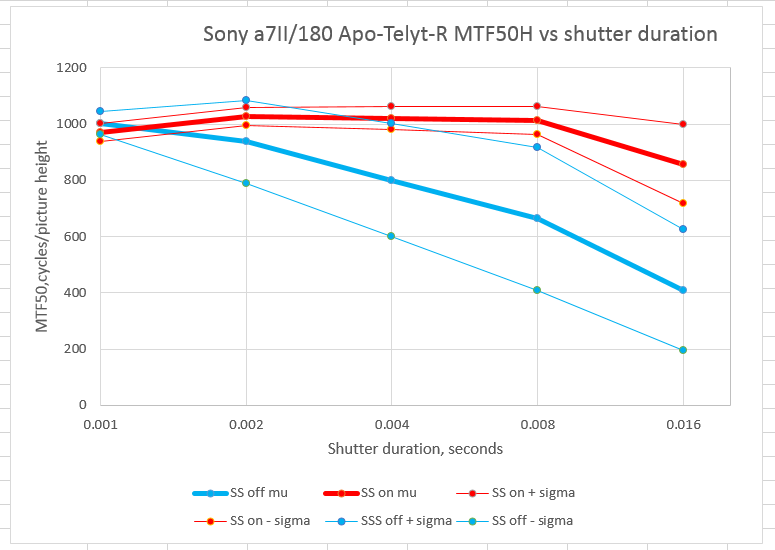The Leica 180mm f/3.4 Apo-Telyt-R is about the longest lens that feels right handheld on the alpha 7 cameras, with the exception of the Sony 70-200 f/4 FE lens. The 180 is really quite well suited to the camera.
How much does IBIS (known to Sony as SteadyShot) help?
I employed a test protocol based on one I used a few days ago.
- The camera: the Sony a7II.
- The lens: the Leica 180mm f/3.4 Apo-Telyt-R, with a Novaflex R to E adapter.
- No filter, this time; I needed all the light I could get.
- The lighting: a single Fotodiox LED-200WA-56 daylight balanced variable-output flood.
- ISO set to 1600, f-stop set to 11, to minimize the effect of manual focusing errors.
- Focusing manually at f/3.4, using the magnifier. The focus point as a Siemens star on the target.
- Drive set to single
- EFCS on
- Manual exposure mode.
- Hold the camera in the “Pete Souza” grip: left palm under base, left fingers bracing the underside of the front part of the lens, elbows against chest.
- Exposure protocol: ND filter to minimum attenuation,, shutter to 1/1000 second, make 16 exposures with new focusing for each, turn the light down a stop, make 16 exposures… until you get to 1/60 of a second or so.
- Inhale, exhale, brace, think calm thoughts, squeeze the shutter release, remembering to “pull through”.
- Develop in Lightroom 5.7.1 with standard settings.
- Crop, export as TIFFs, analyze for horizontal edge and vertical edge MTF50 in Imatest.
- Export the results to Excel, crunch the stats, and graph.
Here’s what I got:
The heavy lines are the average,, or mean, values, for which the mathematical symbol is mu. The light lines are the mean plus and minus the standard deviation, or sigma, of the measurement set, and provide an estimate of repeatability. At least 2 stops of improvement, and more like three at the faster shutter speeds. The difference between the vertical and horizontal curves occurs because of the anisotropic nature of the a7II’s anti-aliasing filter — it mainly works in only one direction.
The 180 is solid to 1/125 second using IBIS, providing virtually the same level of performance as 1/1000 without it.


Thanks and great Jim! Now, it is clear folk!
Very good experiment, I like it! Does IBIS help during focusing? What is your setup?
IBIS helps a lot during focusing. Setup? I use maximum magnification, if that’s what you mean.